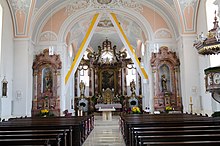St. Michael (Stadtsteinach)
The Church of St. Michael is a listed Roman Catholic church . It is located in the town of Stadtsteinach in the Upper Franconian district of Kulmbach .
history
The parish church was first mentioned in a document in 1306. In 1463 the church was destroyed during the First Margrave War. A late Gothic hall church was built as a follow-up building from 1464. During the Second Margrave War , the church partially burned down as a result of arson. After the reconstruction, the church was again completely destroyed in the Thirty Years War .
Due to the plight of the population, the church could only be restored slowly. Around 1700 the situation got a little better: the church could be furnished with altars again. Plenty of financial support was given around 1729 by Princess Christina Sophia Wilhelmina of Brandenburg .
In 1772 the church had to give way to a pure rococo building due to the artistic change in style . The new church was inaugurated in 1785 when it was finally completed . In the 19th century the furnishings and the organ were adapted to the new tastes of the time.
On February 26, 1903, the church burned down, presumably as a result of arson by children on fire. On the initiative of Pastor Schmitt (1892-1916), a church in the style of the Neo-Rococo was built according to plans by Josef Schmitz and under the supervision of Th. Von werden from Nuremberg . The similarity in style made it possible to reuse the remains of the wall of the old church inexpensively. In 1905 the shell was finished. On September 14, 1905, the four new bells were delivered. The church was consecrated on November 7, 1905 by Friedrich Philipp von Abert .
A competition was held for the interior design. Plans by the architect Anton Bachmann from Munich were implemented . When the First World War broke out in 1912, only the high altar could be built. It was not until 1923 that the remaining pieces of equipment could be added. On May 5, 1942, three bells had to be handed in for armament purposes and the ringing was replaced by a sound box. The bells were returned undamaged in 1947.
Furnishing
The church was equipped with new ones, but also with works from the previous church. The high altar from 1912 is a wooden structure and is stylistically based on the high altar of the Marienweiher pilgrimage church and was made by the Schoyerer company from Cham. On the left side altar is a replica of a Gothic Madonna from 1972, on the right side altar a baroque statue of St. Josef, made around 1750/1760.
The three-part ceiling painting was created by Hans Bayerlein in 1936 . The Way of the Cross is formed from panel paintings from 1779 with a matching rococo frame. Scattered around the church are statues and groups of crosses from the Baroque period. In the baptistery there is a high relief depicting the Entombment of Christ from the early 17th century as well as symbol bars from the second half of the 18th century next to the statues from the 20th century. Outside the church there is a 17th century depiction of the Mount of Olives.
organ
The Strebel organ and the organ prospectus were built in 1911 by the Johannes Strebel organ building company, based on plans by Anton Bachmann . It consisted of two manuals and a pedal , with a pneumatic action . The organ underwent a sound modification in 1960 as well as the conversion to electro-pneumatic action by the Dietmann company, Lichtenfels, it currently has 28 sounding stops .
Bells
The four bells were cast by the Lotter company from Bamberg . You have des 1 , f 1 , as 1 and b 1 as beat notes.
literature
- Günther Heß: St. Michael, Stadtsteinach. Schnell & Steiner, Munich / Zurich 1990, ISBN 978-3-7954-5552-1 .
Web links
- Parish of St. Michael
- Information on the construction of the Strebel organ from the Steinmeyer archive
- YouTube channel for the Strebel organ in St. Michael zu Stadtsteinach
Individual evidence
- ^ Hermann Fischer and Theodor Wohnhaas : The Nuremberg organ building in the 19th century. In: Mitteilungen des Verein für Geschichte der Stadt Nürnberg, Vol. 59, 1972, p. 238. online , accessed on July 20, 2016.
Coordinates: 50 ° 9 ′ 38.6 ″ N , 11 ° 30 ′ 19.8 ″ E






